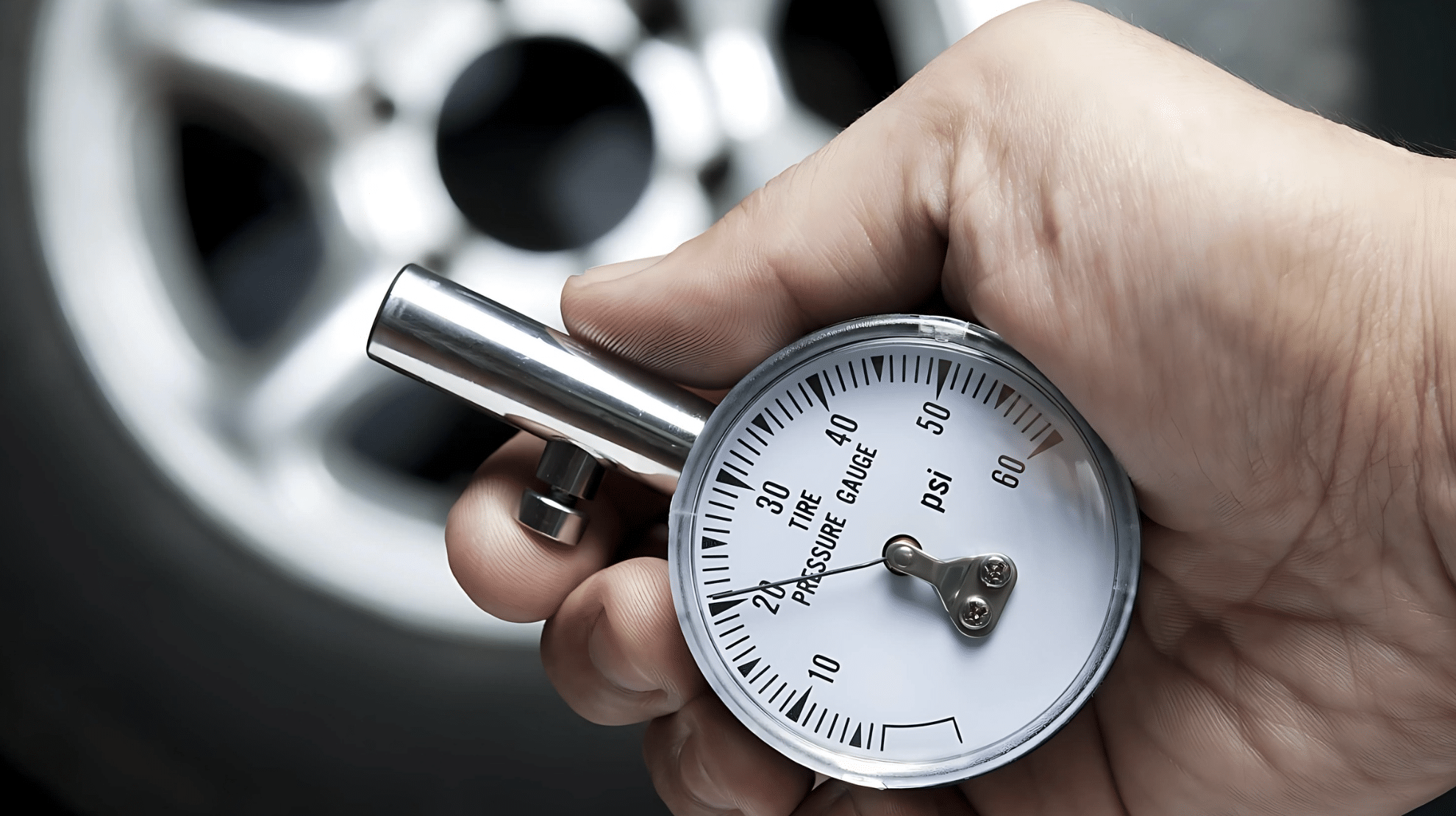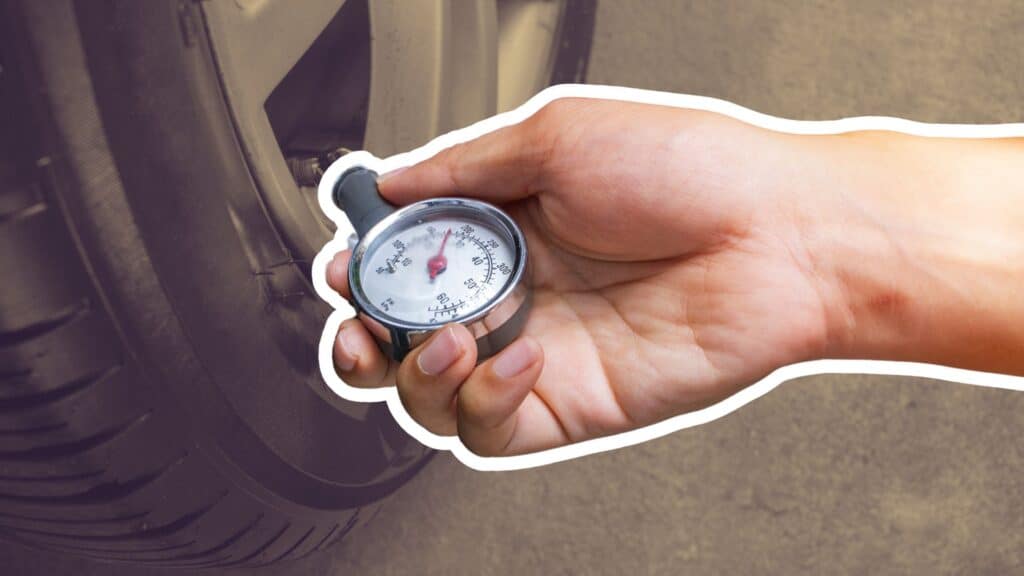Drivers often overlook tire pressure, but it’s a key factor in vehicle safety and performance. Weather changes can significantly impact tire pressure, leading to potential hazards on the road.
Proper tire maintenance is crucial for optimal handling, fuel efficiency, and longevity.
This guide will help you understand how climate affects tire pressure and provide practical tips for inflating your tires year-round.
You’ll learn about the dangers of low tire pressure, how to check your tires correctly, and when to adjust the pressure based on temperature changes.
By following these guidelines, you’ll be better equipped to maintain your tires in various weather conditions, ensuring a safer and more comfortable driving experience.
What Tire Pressure is Too Low?
Let’s start with the basics. Any tire pressure below what your car maker suggests is too low.
This number is usually between 28 and 36 PSI (pounds per square inch), and it can be found in your car’s manual or on a sticker inside the driver’s door.
But here’s the thing – there’s no one-size-fits-all answer. What’s too low for one car might be okay for another. That’s why knowing your car’s specific needs is so important.
The U.S. government says that tire pressure that drops 25% below the recommended level is dangerously low. For example, if your car’s ideal pressure is 32 PSI, anything below 24 PSI is a big no-no.
Even a small pressure drop can cause problems. So, it’s best to keep your tires as close to the recommended pressure as possible.
Reasons for Ups and Downs in Tire Pressure
Ever wonder why your tires seem to have a mind of their own when it comes to pressure? Let’s break it down:
- Temperature Fluctuations: Cold weather causes the air in your tires to huddle up, lowering pressure. Hot weather causes it to spread out, increasing pressure. It’s like your tires are breathing with the seasons!
- Driving Conditions: Cruising down the highway or bouncing along a bumpy road creates heat in your tires, temporarily raising your tire pressure.
- Altitude Changes: Are you heading up a mountain? The thinner air at higher altitudes can cause your tires to lose pressure.
- Air Loss Over Time: Tires naturally lose a tiny bit of air over time, even without holes. It’s slow, but it happens.
- Impact Damage: Hitting a big pothole or bumping a curb can cause sudden air loss or a small leak. Ouch!
Understanding How Climate Affects Tire Pressure

The weather outside can mess with your tire pressure. Let’s break it down:
Cold Weather
When it’s chilly, the air in your tires gets a bit lazy. The molecules slow down and huddle together, taking up less space. This means your tires lose some pressure.
Always check your tire pressure in the morning before you drive. That’s when your tires are the coldest and will give you the most accurate reading.
Hot Weather
Now, when it heats up, it’s a whole different story. The air in your tires gets excited and spreads out, causing the pressure to increase.
Be careful in hot climates. Too much pressure can cause your tires to pop, especially on long trips.
A handy fact to remember: For every 10°F change in temperature, your tire pressure changes by about 1 PSI. So if it’s 70°F when you check your tires and then it drops to 30°F overnight, you could lose 4 PSI!
Knowing this helps you stay on top of your tire pressure no matter what Mother Nature throws your way.
Consequences of Rising Tire Pressure According to Seasons
Let’s chat about how changing seasons can affect your tire pressure and why it matters:
| Season | Key Challenge | Consequence | Why It Matters |
|---|---|---|---|
| Summer | Rising Temperatures | Increased Blowout Risk | Hot air expands, increasing pressure and risking blowouts during long drives. |
| Uneven Tread Wear | Overinflation causes the center of the tire to wear out faster, reducing tire lifespan. | ||
| Winter | Falling Temperatures at Night | False Sense of Security | Tires may appear properly inflated during the day but lose pressure at night, leading to underinflation risks. |
| Reduced Fuel Efficiency | Underinflated tires create more rolling resistance, which causes your car to use more fuel and increases your pump costs. | ||
| Spring/Fall | Fluctuating Temperatures | Frequent Adjustments Needed | Constant temperature changes require regular tire pressure monitoring and adjustments. |
Practical Tips for Maintaining Tire Pressure
Let’s talk about how to keep your tires happy all year round:
1. Regular Monitoring
Make it a habit to check your tire pressure at least once a month. It’s also smart to do a quick check before you take a long trip.
Get yourself a good tire pressure gauge—a small investment that can save you big headaches. Remember to check your spare tire, too.
It’s easy to overlook, but you’ll be glad it’s ready when needed.
2. Seasonal Adjustments
As the weather changes, so do your tire pressure needs. Think of it as dressing your tires for the season – they need different care in winter and summer.
Winter Tips:
- When Jack Frost comes knocking, your tires might need some extra air. Add some air to your tires if the temperature takes a big dip.
- Keep an eye out for signs that your pressure might be low.
- If your car’s tire pressure light pops on or you start hearing more road noise than usual, it’s time to check those tires.
- Cold tires can affect your car’s handling, so be extra careful on those frosty mornings.
Summer Tips:
- When it’s hot enough to fry an egg on the sidewalk, your tires might get too puffy. If they’re overinflated on those scorching days, let out a little air.
- Also, take a good look at your tires now and then. If the center of the tread is wearing faster than the edges, your tires might carry too much air.
- Hot roads can be tough on tires, so park in the shade when possible to keep them cooler.
3. TPMS (Tire Pressure Monitoring System)
Your car’s TPMS is like a helpful friend who taps you on the shoulder when your tires need attention. It’s great, but don’t rely on it completely.
It’s still important to check your tires manually. Some TPMS systems only alert you when the pressure is dangerously low so that regular checks can catch issues early.
If your TPMS light comes on during a big temperature swing, don’t panic. Driving for a few minutes often warms your tires and turns the light off. If it stays on, it’s time to check your pressure and add some air if needed.
Underinflation vs. Overinflation
Let’s talk about the Goldilocks zone of tire pressure – not too little, not too much, but just right.
| Aspect | Underinflation | Overinflation |
|---|---|---|
| Description | Tires are too relaxed and floppy like they’re underfed. | Tires are too perky and bouncy, like they’ve had too much coffee. |
| Risks | – Tires bend too much, leading to overheating and possible blowouts. – Increased fuel consumption. – Faster wear on tire edges. |
– Reduced road grip, like running in stiff shoes. – Bumpier ride. – Faster wear in the center of the tire. – More prone to damage from potholes. |
| Symptoms | – Squishy ride, like driving on marshmallows. – Longer stopping distances. The tires look slightly flat. |
– Bouncy ride, like being on a pogo stick. – More slipping, especially in wet conditions. – The middle of the tire is more worn than the edges. |
| Seasonal Note | It is more common in winter when cold air contracts. | It is more common in summer when heat expands the air inside tires. |
The Bottom Line
Properly inflating your tires is key to a safe, efficient, and comfortable ride.
By understanding how weather affects tire pressure and the risks of under- and overinflation, you’re better equipped to take care of your tires year-round.
Remember to check your tire pressure monthly and before long trips, especially when the seasons change. Don’t rely solely on your TPMS—manual checks are still important.
Maintaining the right tire pressure keeps you safer and saves you money on fuel and tire replacements.
So, next time you’re about to hit the road, take a moment to check your tires. It’s a small habit that can make a big difference in your driving experience and safety.
Frequently Asked Questions (FAQs)
How Often Should I Check My Tire Pressure?
Check your tire pressure at least once a month and before long trips. It’s a quick task that can prevent big problems.
Can I Rely Solely on My TPMS (Tire Pressure Monitoring System)?
While TPMS is helpful, it’s not foolproof. Regular manual checks with a tire gauge are still important for accurate pressure readings.
What’s the Correct Tire Pressure for My Car?
The recommended pressure is usually between 28 and 36 PSI, and it can be found in your car’s manual or on the driver’s side door jamb.


